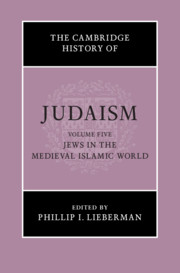Book contents
- The Cambridge History of Judaism
- The Cambridge History of Judaism
- The Cambridge History of Judaism
- Copyright page
- Contents
- Figures
- Acknowledgments
- Introduction
- Part I Jews in the Medieval Islamic World
- A. The Islamic World in the Middle Ages
- B. Regional Surveys
- Chapter 4 The Maghrib and Egypt
- Chapter 5 The Jews of Muslim Spain
- Chapter 6 Beyond Crescent and Cross
- Chapter 7 Yemen and India from the rise of Islam to 1500
- Chapter 8 The Jews of Northern Arabia in Early Islam
- Chapter 9 Judaism in Pre-Islamic Arabia
- Chapter 10 The Islamic East
- Part II Social and Institutional History
- Part III Spiritual and Intellectual History
- Index
- References
Chapter 4 - The Maghrib and Egypt
from B. - Regional Surveys
Published online by Cambridge University Press: 21 August 2021
- The Cambridge History of Judaism
- The Cambridge History of Judaism
- The Cambridge History of Judaism
- Copyright page
- Contents
- Figures
- Acknowledgments
- Introduction
- Part I Jews in the Medieval Islamic World
- A. The Islamic World in the Middle Ages
- B. Regional Surveys
- Chapter 4 The Maghrib and Egypt
- Chapter 5 The Jews of Muslim Spain
- Chapter 6 Beyond Crescent and Cross
- Chapter 7 Yemen and India from the rise of Islam to 1500
- Chapter 8 The Jews of Northern Arabia in Early Islam
- Chapter 9 Judaism in Pre-Islamic Arabia
- Chapter 10 The Islamic East
- Part II Social and Institutional History
- Part III Spiritual and Intellectual History
- Index
- References
Summary
The Jewish communities of Egypt and North Africa are arguably the best-documented Jewish communities in the medieval Islamic world (with the possible exception of those of Palestine). The riches of the genizot of Cairo and geonic responsa open unparalleled vistas for the study of Jewish life in these regions and attest to the strong links between them. As explored further below, Egypt and North Africa shared a common orientation toward the Mediterranean and were tied by a vibrant maritime and overland trade. In 969, the dynasty that had ruled over the central Maghrib from the beginning of the century conquered Egypt and subsequently proclaimed this victory by establishing its new capital in it (Cairo, Arabic al-Qāhira, “the victorious”). The transfer of the religious, military, and administrative center of the empire from the Maghrib to Egypt constituted another strong connection between the two regions. The combination of these commercial and political ties brought about a substantial migration and settlement of Maghribī Jews to Egypt, a process that further bonded the regions together and proved decisive in shaping their Jewish communities.
- Type
- Chapter
- Information
- The Cambridge History of Judaism , pp. 127 - 163Publisher: Cambridge University PressPrint publication year: 2021

